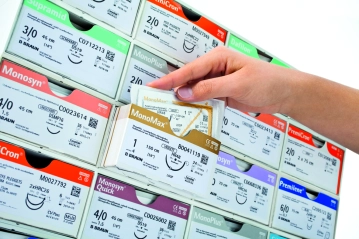All suture materials on the market are standardized and defined in the European Pharmacopeia. Two classifications of suture size are in common use, the definition of the European Pharmacopeia (EP) and that of the United States Pharmacopeia (USP).
Initially, suture size as defined by the United States Pharmacopeia (USP) were chosen arbitrarily. The definition as laid down in the European Pharmacopeia is much simpler and more transparent. It is based on the decimal system. This size classification is called "metric". The size indicates the thickness of the suture in 1/10 mm and, unlike the standard definition, reflects the diameter of the suture (e.g.: metric 1 = 1/10 mm = 0.1 mm suture diameter). In order to facilitate the switchover and rule out any confusion, manufacturers in the Federal Republic of Germany list the suture size both in metric and standard USP designation on all packages (Harmsen W. S. 1994) (Thiede A., Geiger D. 1998).
By now the 19th United States Pharmacopeia has adopted the metric size classification of the European Pharmacopeia. This ensures a quasi-legal adoption of a worldwide uniform size classification in suture materials.
There is a wide range of surgical needles adapted to their respective surgical applications. They are classified according to certain specifications:
Curvature and chord length:The curvature is based on a fraction of the arc of a circle; from 1/4 circle up to 5/8 circle. The more curved the needle, the closer the points of entry and exit are to each other. In confined surgical fields such as the anal canal, it may be helpful to use a heavily curved needle. Skin sutures normally use 1/2 circle needles. The chord length or bite width of the needle represents the linear distance between the needle point and the swage end of the needle.
Needle point: Needles may be classified, among other things, as cutting needles with a triangular cross-section for hard to penetrate tissue (e.g., for skin suturing) or round bodied needles with slender round tips for all friable tissues, leaving a narrow needle track.
Unlike eyed needles, where the thread has to be inserted into the eye of the needle, swaged needles (already armed with the suture) allow atraumatic suturing; since in eyed needles the eye holds the doubled thread, it causes more trauma (wider track) when penetrating tissue.
The ideal universal suture material does not exist. Layered tissue-specific wound closure requires different materials. Suture material must meet the following important requirements
*High degree of sterility
*high tensile strength
*Knot security
*Tissue tolerance
*No capillary effect
*Reasonable cost.
Monofilament sutures are characterized by low tissue drag. However, their smooth surface and stiffness degrade knot security, which must be compensated by a higher number of throws (approx. 6 to 8). In addition, monofilament sutures have a considerably lower tensile strength than braided forms.
The greater flexibility of multifilament sutures braided/plied from several filaments results in better knot security. One drawback is the capillary or wick effect. Due to its rough surface, the suture does not pass smoothly through the tissue (sawing effect) and thus may cut through it. To minimize this undesirable effect and optimize tissue passage, some braided sutures are coated (pseudomonofilament).
Absorbable sutures are used wherever tissue must be reapproximated for a certain amount of time (intestinal anastomoses, muscle sutures, subcutaneous sutures, vascular ligatures).
Non-absorbable sutures are used wherever tissue strength requires permanent or prolonged buttressing of tensile tissue strength. This is particularly true for locations with high mechanical strain (e.g., the Shouldice suture in hernia repair, mesh fixation in the Lichtenstein procedure, and also in sutures of the vascular wall).
Non-absorbable sutures are called for whenever suture extraction is planned (skin). One exception is the intradermal skin suture, which may also be fashioned with absorbable monofilament suture material.
The suture size used depends on the site. On the hands and in the face, for example, finer suture sizes of 4/0 or 5/0 are used. Tissues around joints are exposed to higher strain and should therefore be sutured with heavier material (2/0 or 3/0). Due to their capillary effect (possible contamination of the wound) braided sutures are not used when suturing skin.
Hand-sewn gastrointestinal anastomoses are usually fashioned with running single-layer seromuscular sutures, preferably with absorbable monofilament material.
Vascular sutures should be closely spaced, everting, and running. Best for this are non-absorbable monofilament sutures.
Due to their better knot security, free ligatures as well as suture ligations, for example on vessel stumps, should be performed with braided sutures, although monofilament material is also used in suture ligation.
The goal in peritoneal suturing is to ensure a fluid-proof seal of the peritoneum. Particularly after procedures in inflammatory conditions, the peritoneal exudate is often contaminated with pathogens despite extensive irrigation. This is tolerated better by the peritoneum than by the muscles and subcutaneous tissue. Abdominal wall abscess is usually caused by a subfascial process rather than non-sterile dressing changes. Peritoneal sutures are performed with absorbable material and may use monofilament or braided sutures with antibacterial coating.
Fascias are bradytrophic tissues and are usually closed with a running suture. Therefore, they should be sutured with strong, absorbable monofilament suture material with a long half-life or absorption time.
Subcutaneous sutures are intended to prevent tissue pockets and are usually fashioned with absorbable, braided suture material.

